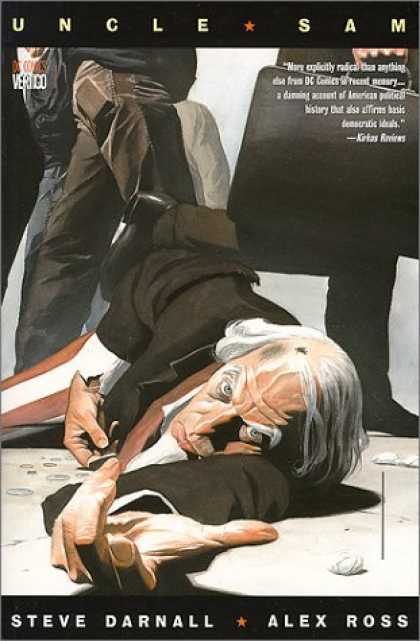
Steve Darnall / Alex Ross
1997
A tramp lies prone on the ground, with loose change scattered around him. His clothes are tattered and dirty, and his face is old and worn, but he still bears an uncanny resemblance to…someone strangely familiar.
UNCLE SAM is a peculiar story, in that, it’s quite clearly and explicitly about the state of the American government (at the time, anyway) whilst also has a main character who’s obviously real, and has existed for a long, long time. OR HAS HE?
Yes, he has. UNCLE SAM is both a parable and a literal representation of said parable: Uncle Sam himself spends the majority of the book muttering famous quotes from American history, and searching for something. Is it his dignity? Is it belief in people? Is it hope that the country he stands for can remember what it stands for? Try, all of the above. Sam suffers flashbacks to frontier times, and the Civil War, as he starts to remember who he is. Has he always being the symbol of democracy we know him has, or did he eventually end up that way? Again, it’s a bit of both.
There is a superhero origin story buried under all the rhetoric, and the glimpses we get are exciting and interesting enough to make us want more (youths try to burn the ‘bum’ alive, but the flames don’t harm him, and he knows exactly what beliefs fuel people he meets, etc). Uncle Sam has appeared in certain DC comics as a full-fledged superhero, powered by the very country itself. The end of this story suggests that Uncle Sam might have been this one, once, but he could have just as easily have never existed.
If this all seems a little confusing, that’s because it is. By being everything and nothing at the same time, Steve Darnall has created a story that suggests the obvious, but rewards the theoretical. Perhaps the best thing in UNCLE SAM, though, is a short essay on Uncle Sam as a mythological figure in American history, and his real origin.
Finally, you really can’t berate the artwork of Alex Ross. He’s long since had the reputation for creating ‘real-world’ representations of superheroes, so using him to paint this book is an obvious, but worthwhile, choice. The only possible gripe is that you’re often left feeling that his work shouldn’t be confined to small frames, but, that’s the nature of comics so what’re you going to do?
UNCLE SAM is a peculiar story, in that, it’s quite clearly and explicitly about the state of the American government (at the time, anyway) whilst also has a main character who’s obviously real, and has existed for a long, long time. OR HAS HE?
Yes, he has. UNCLE SAM is both a parable and a literal representation of said parable: Uncle Sam himself spends the majority of the book muttering famous quotes from American history, and searching for something. Is it his dignity? Is it belief in people? Is it hope that the country he stands for can remember what it stands for? Try, all of the above. Sam suffers flashbacks to frontier times, and the Civil War, as he starts to remember who he is. Has he always being the symbol of democracy we know him has, or did he eventually end up that way? Again, it’s a bit of both.
There is a superhero origin story buried under all the rhetoric, and the glimpses we get are exciting and interesting enough to make us want more (youths try to burn the ‘bum’ alive, but the flames don’t harm him, and he knows exactly what beliefs fuel people he meets, etc). Uncle Sam has appeared in certain DC comics as a full-fledged superhero, powered by the very country itself. The end of this story suggests that Uncle Sam might have been this one, once, but he could have just as easily have never existed.
If this all seems a little confusing, that’s because it is. By being everything and nothing at the same time, Steve Darnall has created a story that suggests the obvious, but rewards the theoretical. Perhaps the best thing in UNCLE SAM, though, is a short essay on Uncle Sam as a mythological figure in American history, and his real origin.
Finally, you really can’t berate the artwork of Alex Ross. He’s long since had the reputation for creating ‘real-world’ representations of superheroes, so using him to paint this book is an obvious, but worthwhile, choice. The only possible gripe is that you’re often left feeling that his work shouldn’t be confined to small frames, but, that’s the nature of comics so what’re you going to do?



